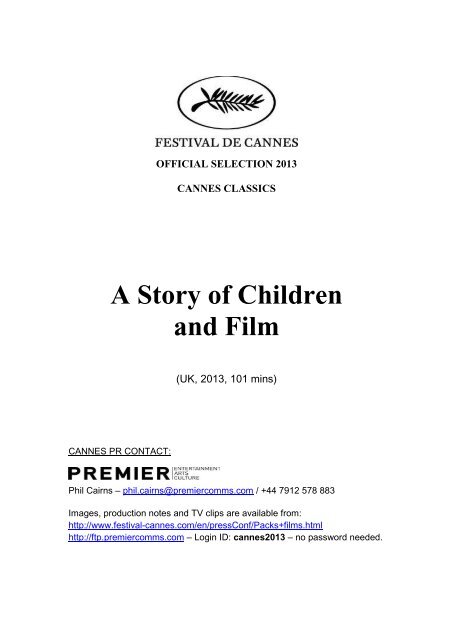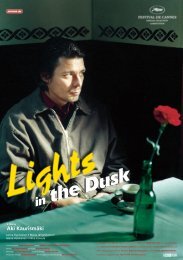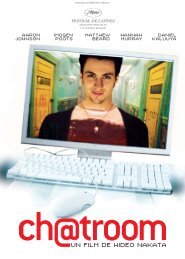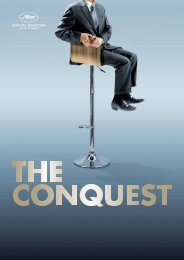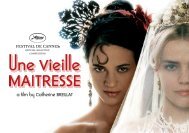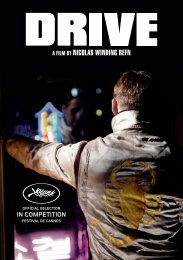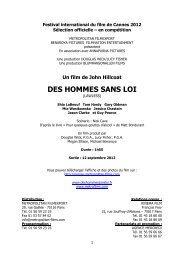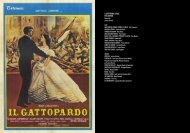English - Cannes International Film Festival
English - Cannes International Film Festival
English - Cannes International Film Festival
You also want an ePaper? Increase the reach of your titles
YUMPU automatically turns print PDFs into web optimized ePapers that Google loves.
OFFICIAL SELECTION 2013<br />
CANNES CLASSICS<br />
A Story of Children<br />
CANNES PR CONTACT:<br />
and <strong>Film</strong><br />
(UK, 2013, 101 mins)<br />
Phil Cairns – phil.cairns@premiercomms.com / +44 7912 578 883<br />
Images, production notes and TV clips are available from:<br />
http://www.festival-cannes.com/en/pressConf/Packs+films.html<br />
http://ftp.premiercomms.com – Login ID: cannes2013 – no password needed.
SHORT SYNOPSIS<br />
Two children, Laura and Ben, play in a room in Edinburgh,<br />
Scotland. At first they are shy, then they get stroppy, then show<br />
off, then tell stories, then wreck the toy that they’re playing with.<br />
Each of these aspects of childhood inspires a journey through<br />
world cinema, in which we see how great films from 25 countries –<br />
classics as well as rarer movies – have depicted shyness,<br />
stroppiness, storytelling and violence in childhood, plus other<br />
themes too: adventure, surrealism, and doggedness. Laura and<br />
Ben stay in a room, but A Story of Children and <strong>Film</strong> travels the<br />
world. The kids’ play is a microcosm and, so, the film begins and<br />
ends with one of the most famous microcosms in the history of art.
BFI<br />
FILM 4<br />
BofA Productions<br />
Present<br />
A Story of Children<br />
and <strong>Film</strong><br />
Written and directed by<br />
Mark Cousins<br />
-<br />
Producers<br />
Mary Bell and Adam Dawtrey<br />
-<br />
Editor<br />
Timo Langer<br />
-<br />
<strong>Film</strong> Advisor and Researcher<br />
Neil McGlone<br />
-
French Shoot<br />
Steadicam DOP Marc Benoliel<br />
Focus Puller Timothee Lebarbenchon<br />
Electrician Wilhem van Overbeck<br />
Children Ines Lopez Salvador Cazals<br />
Equipment Panavision Marseille and Transpalux Marseille.<br />
-<br />
Dubbing Mixer<br />
Ali Murray<br />
Commentary Record<br />
Iain McKinna<br />
-<br />
For the BFI<br />
Director of Lottery <strong>Film</strong> Fund<br />
Ben Roberts<br />
Senior Production and Development Executive<br />
Lizzie Francke<br />
Head of Production<br />
Fiona Morham<br />
Production Finance<br />
Amanda Pyne<br />
Business Affairs Manager<br />
Ben Wilkinson<br />
For <strong>Film</strong> 4<br />
Tabitha Jackson<br />
David Cox<br />
Laura Baglow
For BofA<br />
Business Affairs Jillian Morris<br />
Production Accountant Catrina Luna<br />
Accountant Shipleys Insurance, Media Insurance Brokers<br />
Special Thanks<br />
O’Melveny & Myers LLP (Libby Savill and Sarah Caughey)<br />
Dr Jean Marc Boulon, Mme Laurence Chardon and the staff of Saint Paul de<br />
Mausole, Saint-Remy de Provence<br />
Laura Moreton, Ben Moreton<br />
Thanks<br />
Anita Oxburgh, Peter Von Bagh, Ehsan Khoshbakht, Brigitte and Hubert<br />
Rocca of the Hotel Le Chalet Fleuri, Saint-Remy-de-Provence, The Danish<br />
<strong>Film</strong> Institute, Mohammad-Ali Talebi, Allan Fish, Phil Moreton, Angela<br />
Moreton,<br />
the Edinburgh <strong>International</strong> <strong>Film</strong> <strong>Festival</strong>, the 8 1/2 Foundation, GLM, Judith<br />
Dawtrey, Ascension Garcia, Celine Carroll, Bashabi Fraser, Karel Och, Eriona<br />
Vyshka and the Albanian <strong>Film</strong> Archive, Thomas Logoreci, Iris Elezi, Stuart<br />
Cosgrove, John Archer, Julian Ward, Timour Mambety, Lizelle Bischoff, Tilda<br />
Swinton, Benjamin Kracun, Anna Fomicheva, Tristan Priimägi of the Estonian<br />
<strong>Film</strong> Foundation, Martin Pope, Marc Samuelson, Philippe Carcassonne,<br />
Sandrine Boulet, Milena Poylo , Pascale Beraud and Vassili Meimaris of the<br />
Commission Regionale du <strong>Film</strong> Provence-Alpes-Cotes d’Azur<br />
-<br />
Music<br />
The Original Score for Ernst Lubitsch’s Kohlhiesel’s Daughters, composed by<br />
Aljoscha Zimmerman, performed by the Aljoscha Zimmerman Ensemble. With<br />
kind permission of Sabrina and Hanna Zimmerman. Licensed courtesy of<br />
Bayerische Rundfunk.<br />
Premiere Communion de la Vierge, from Vingt Regards sur L’enfant Jesus, by<br />
Olivier Messiaen, performed by Hakon Austbo. Licensed courtesy of Naxos<br />
Rights US Inc, and Universal Music Publishing.
-<br />
Van Gogh Paintings<br />
Landscape from Saint-Remy, Ny Carlsberg Glyptotek, Copenhagen,<br />
photographer Ole Haupt.<br />
Enclosed Wheat Field with Rising Sun, Sun Over Walled Wheat Field and<br />
Landscape with Wheatfields and Rising Moon, Collection Kroeller-Mueller<br />
Museum, Otterlo, the Netherlands.<br />
Enclosed Wheat Field with Reaper, bpk/Kupferstichkabinett, SMB/Joerg P.<br />
Anders<br />
Fields with Poppies, with kind permission of Kunsthalle Bremen.<br />
Wheatfield with Reaper, Self Portrait with Grey Felt Hat, Van Gogh Museum,<br />
Amsterdam.<br />
Self Portrait, 1887, Detroit Institute of Arts, USA/City of Detroit Purchase/The<br />
Bridgeman Art Library.<br />
Self Portrait, Autumn 1886, Collection of the Gemeentemuseum Den Haag.<br />
Self Portrait with Bandaged Ear, The Samuel Courtauld Trust, The Courtauld<br />
Gallery, London<br />
Self Portrait 1887-88, courtesy Foundation E.G. Buehrle Collection.<br />
Self Portrait, August 1889, courtesy National Gallery of Art, Washington DC<br />
-<br />
The Child Actors<br />
Andrew Ray, Roma Burlaka, Jackie Coogan, Rolf Wenkhaus, Koki Maeda,<br />
Stephen Archibald, Pascal Lamorisse, Lars Henning-Jensen, Jean-Pierre<br />
leaud, Natalya Ovodova, Saeed Alamdari & Hamid Alamdari, Georges<br />
Poujouly & Brigitte Fossey, Stan Laurel and Oliver Hardy, Hadi Alipor, Marilyn<br />
Harris, Ana Torrent, Zdenek Lsiburek, Lynne Ramsay Jr., Noufou Ouedraogo,<br />
Yuya Yagira, Tomoka Tabata, David Bradley, Rick Lens, Karolina Ostrozna &<br />
Kasia Szczepanik, Fredrik Becklen & Marie Ohman, Billy Chapin & Sally Jane<br />
Bruce, Lissa Balera, Jared Gilman & Kara Hayward, Margaret O’Brien and<br />
Judy Garland, Shirley Temple, Bertil Guve, Aida Mohammadkhani, Sameneh<br />
Jafar-Jalali, Tokkan Kozo & Takayuki Suematsu, Tony Wager & Jean<br />
Simmons, Vladimir Kosyrev, Igor Fomchenko, Ajith Kumar H.M, Karen<br />
Fergusson, Hayam Masao & Bakuden Kozo, Henry Thomas, Xue Bai, Filipp<br />
Yankovsky<br />
-<br />
In solidarity with<br />
Jafar Panahi
-<br />
For Hanway <strong>Film</strong>s<br />
Kate Hide<br />
Mark Lane<br />
Justin Kelly<br />
Thomas Mann<br />
Fabien Westerhoff<br />
-<br />
www.astoryofchildrenandfilm.com<br />
designed by Ehsan Khoshbakht, Ehsan Irannejad and Mark Cousins<br />
KB Kinderwrite with kind permission from Khrystine Bosland<br />
BofA logo design by Euan Dawtrey<br />
-<br />
Developed with the support of the BFI’s <strong>Film</strong> Fund<br />
Copyright BFI/BofA Productions 2013
THE MAKING OF A STORY OF CHILDREN AND FILM<br />
DIRECTOR’S NOTES<br />
My niece and nephew, Laura and Ben, visited me in Edinburgh, in Scotland,<br />
and so I filmed them. One shot, 12 minutes. No camera moves. I don’t much<br />
like camera moves.<br />
Then I started chatting to people about making a film about kids and cinema.<br />
I’ve been interested in kids for a while. The first thing I ever directed for TV, in<br />
1989, was about a kids’ festival in Glasgow. My first film for the big screen,<br />
The First Movie, was about kids and cinema. I co-set up a charity, Scottish<br />
Kids are Making movies, in the mid 90s. My work with Tilda Swinton,<br />
especially the 8 ½ Foundation, has often been for children.<br />
So I wrote an idea for a film about kids in movies. In a gap in the writing, I rewatched<br />
the footage of Ben and Laura, and realised that in the just one shot,<br />
they went through lots of the emotions of childhood – shyness, showing off,<br />
stroppiness, etc. This could be a way of structuring my film, I thought.<br />
Previously, I had made The Story of <strong>Film</strong>: An Odyssey, which was produced<br />
by John Archer of Hopscotch films. John and I had planned a film that would<br />
last perhaps, 4 ½ hours, or maybe 6 hours, but it grew to 930 minutes, 15 ½<br />
hours. I knew that I didn’t want to make something huge like that about kids,<br />
and I didn’t want to make a straight history of kids in cinema. I needed a way<br />
of containing the subject, giving it a scale and, also, I hoped, a degree of<br />
richness or a poetics. The shot of Laura and Ben could provide this. Using it<br />
would allow me to look at kids through movies rather than directly at movies<br />
themselves. This is something like the opposite of The Story of <strong>Film</strong>: An<br />
Odyssey. Or, rather, it’s that film combined with The First Movie. I liked this<br />
thought, but was worried about it too, as I knew some people wouldn’t like it.<br />
With these ideas in mind, I went back to the writing of the film. When I was in<br />
school, I loved it when they gave us big sheets of paper on which to draw.<br />
Ever afterwards, when I have something to plan or write, I start with a large<br />
sheet of paper. So it was with A Story of Children and <strong>Film</strong>. I realised early<br />
on in my thinking that, unlike my other films, it would not be about a journey, a<br />
road movie, it would be a series of themes. So I scribbled each childhood<br />
theme – shy, secretive, performative, destructive, watching, leaving,<br />
adventurer, dreaming, grumpy, scared, loss, limited horizon, daring, class,<br />
adult, dog with a bone, alone – on a big page, and drew a rough box around<br />
each. Then, each time I watched a film, if it had a good scene about one of<br />
those themes, I wrote it down in the relevant box. I find the big sheet of paper<br />
approach so much more useful than, say, a linear document on a computer.<br />
The former allows me to jump between themes, notice connections, etc. It’s<br />
more creative, more like drawing.
Then producers Adam Dawtrey and Mary Bell came on board. I’d known<br />
them for years and we had often talked about children and film. They were<br />
the film industry producers on the 8½ Foundation, a project about kids and<br />
cinephilia that I did with Tilda Swinton, Matt Lloyd and Tamara Van Strijthem.<br />
As I wrote the script, I started to choose the films that I would feature. I knew<br />
that I wanted them to be very international. I wanted some classics but lots of<br />
less well known movies too, not because they are less familiar, but because<br />
they are great. I also knew that a lot of the movies would be directed by<br />
women. I asked for suggestions of kids films from a great Swedish producer,<br />
Anita Oxburgh, and from the director of the Karlovy Vary <strong>Film</strong> <strong>Festival</strong>, Karel<br />
Och. Most of all, my friend Neil McGlone sent me some remarkable films I<br />
hadn’t seen, including Melody for a Street Organ by Kira Muratova, a director<br />
whose work I’ve been passionate about, and been talking about, for years.<br />
Neil became invaluable to me in my selection, and is the film’s researcher and<br />
film advisor.<br />
The editor who has cut all my feature length films, Timo Langer, started<br />
cutting the movie. Usually Timo and I’d have a two metre long timeline pinned<br />
onto the wall of the edit suite, but this time we only had a print of a small<br />
painting by Paul Cezanne. This is because we felt that we were not making<br />
something too linear, rather we were editing a portrait film, a documentary<br />
with different hues and tones. This was an unusual move, I think, but we<br />
wanted to challenge ourselves.<br />
I had written an opening of the film to be shot in Saint Remy in France, where,<br />
in 1889, the painter Vincent Van Gogh was in hospital and convalesced.<br />
Producers Adam and Mary set up a half day shoot there. We filmed in the<br />
room where Van Gogh slept. I wanted the window open so that the curtains<br />
would blow. It was so windy outside that the pictures in the room nearly blew<br />
off the walls. Marc Benoliel was our steadicam DOP for this shot. I wanted to<br />
be able to see the landscape from well inside the building. This meant lighting<br />
the rooms to make them brighter so that, even from far back, we could see<br />
the outside.<br />
The steadicam shot recurs at the end of our film. I wanted it to look slightly<br />
different the second time so asked Marc to use a 50mm lens for the second<br />
shot, compared to a 35 mm lens for the first, thus changed the depth of field.<br />
We arranged for two French children, Salvador and Ines, to play with balloons<br />
in the field outside Van Gogh’s room. This refers to something that happens<br />
in the film itself.<br />
Then we came back from France and finished cutting the film. As we did,<br />
Adam talked to me about how, from the birth of cinema, the movie camera<br />
has always been drawn to children, and, in the era of camcorders and then,<br />
more recently, phone cameras, kids have been amongst the most filmed<br />
things. Talking together, we realized that no other art form has ever been so<br />
obsessed with the experience of childhood. I had been writing about the
affinity between children and cinema, and these conversations improved my<br />
script.<br />
Then I recorded the voice-over in a sound studio on Edinburgh and Ali<br />
Murray, also from my home town, who had done the lovely sound on my film<br />
What is this <strong>Film</strong> called Love?, did the sound mix.<br />
A Story of Children and <strong>Film</strong> was finished but, hopefully, only just starting.<br />
Mark Cousins<br />
PRODUCERS’ NOTES by Adam Dawtrey<br />
Sometime in early 2009, I bumped into Mark Cousins on the street in<br />
Edinburgh, and asked what he was up to. He said that he and Tilda Swinton<br />
had dreamed up a new idea for a film festival that summer, which involved<br />
pulling the Screen Machine, a 38-ton mobile cinema, by hand across the<br />
Scottish Highlands, showing great movies in small villages along the way.<br />
They called this wild idea the Pilgrimage.<br />
Mark had consulted the British Tug-of-War Association about how many<br />
people it would take to pull a truck of that size, and showed me some figures<br />
scribbled on the back of an envelope. Mark was a bit troubled about his<br />
calculations. “I’m not quite sure,” he confessed. “It’s either 10 people, or 1,000<br />
people. I guess we won’t find out until we actually try. It might be a disaster.”<br />
I decided then and there that my family – myself, wife Mary Bell and our two<br />
sons, then 8 and 12, both film mad – had to become Pilgrims.<br />
Mark may have been uncertain about whether he and Tilda could pull off this<br />
lunatic scheme, but I had no doubt whatsoever. I knew it would be a once-ina-lifetime<br />
experience for anyone who took the plunge and trusted in their<br />
vision. And so it proved. Out of this remarkable trip, Mary and I became<br />
involved in Mark and Tilda’s 8 ½ Foundation, which introduces Scottish<br />
children to the riches of world and classic cinema.<br />
So when Mark called last autumn to ask if Mary and I would like to produce A<br />
Story of Children and <strong>Film</strong>, it took us about a second to say yes. After The<br />
First Movie, The Story of <strong>Film</strong> and What Is This <strong>Film</strong> Called Love?, I had<br />
already realized that he’s touched with genius as a director.<br />
After spending 25 years as a film journalist, and the past five years working<br />
with producers to develop feature projects, being invited to make my own<br />
debut as a producer by such a unique filmmaker was an extraordinary gift. It<br />
sums up the inclusive generosity of Mark’s talent, which is also reflected in his<br />
constant use of the phrase “as you know” – with which he prefaces any piece
of information that you might not know, thus making you feel much smarter<br />
and better informed than you really are. It’s how he makes his audience feel.<br />
Producing A Story of Children and <strong>Film</strong> was also a chance to work with my<br />
wife Mary, who has 30 years’ experience as a producer of iconic TV comedy<br />
(Father Ted, Have I Got News For You etc), and back in the mists of time,<br />
produced a short film, Work Experience, which won an Oscar. We set up BofA<br />
Productions – named after Bridge of Allan, where we lived since moving up<br />
our family to Scotland in 2007.<br />
Producing for Mark, rather like walking through an airport with him, is an<br />
experience of racing to keep up. Intellectually, creatively and practically, he’s<br />
lightning quick. He knows exactly what he wants, and has generally done it<br />
within hours of saying he’s going to. Finding the money comes later. But he’s<br />
also intensely collaborative, as long as you can keep pace.<br />
Our funders at the BFI and Channel 4, Lizzie Francke and Tabitha Jackson,<br />
were remarkably supportive of Mark’s method and vision, and fleet enough of<br />
foot to be there when we needed them. This film simply wouldn’t have<br />
happened without either of them.<br />
CAST<br />
Laura and Ben Moreton, aged 11 and 10, live in Frodsham in Cheshire,<br />
England, and go to school in nearby Helsby. They are Mark Cousins’ niece<br />
and nephew.<br />
The two French children that we see at the end of the film are Ines Lopez<br />
and Salvador Cazals, both aged 11. They live near Saint Remy in Provence.<br />
PRODUCTION STILLS<br />
These can be downloaded here;<br />
(this link is coming soon)<br />
THE TRAILER FOR THE FILM AND THE MAKING OF<br />
These are on our youtube channel, here:<br />
(this link is coming soon)
THE COUNTRIES OF THE FILMS<br />
Albania<br />
Burkina Faso<br />
China<br />
Czech Republic<br />
Denmark<br />
England<br />
Finland<br />
France<br />
Germany<br />
India<br />
Iran<br />
Japan<br />
Korea<br />
Kurdish Iraq<br />
Latvia<br />
Mexico<br />
Netherlands<br />
New Zealand<br />
Poland<br />
Russia<br />
Scotland<br />
Senegal<br />
Spain<br />
Sweden<br />
Ukraine<br />
USA
DIRECTOR’S FILMOGRAPHY AND CV<br />
Dear Mr Gorbachev (assoc d with Michael Grigsby, 60 mins, 1989)<br />
Children's <strong>Festival</strong> (d, 8 mins, 1990)<br />
Gulf War: Scottish Eye (d, 48 mins, 1991)<br />
Another Journey by Train (co-d with Mark Forrest, 59 mins, 1993)<br />
Ian Hamilton Finlay, In a Wee Way (d, 40 mins, 1996)<br />
I remember IKWIG (d, 40 mins, 1996)<br />
Scene by Scene (d, 25 x 60 min documentary interviews, 1997-<br />
2001)<br />
Cinema Iran (w,d 59 mins, 2005)<br />
On the Road with Kiarostami (w,d, 28 mins, 2005)<br />
Kenny Richie (co-d with Irvine Welsh, 12 mins, 2008)<br />
8 1/2 (co-w, co-d with Tilda Swinton, 23 mins, 2008)<br />
The First Movie (w,d,dp, 76 mins, 2009)<br />
The Story of <strong>Film</strong>: An Odyssey (w,d,dp 930 mins, 2011)<br />
What is this <strong>Film</strong> Called Love? (w,d,dp, 75 mins, 2012)<br />
Dear Georges Melies (w, co-d, co-dp, with Tilda Swinton and 102<br />
children, 8 ½ mins, 2013)<br />
A Story of Children and <strong>Film</strong> (w,d,dp, 104 mins, 2013)<br />
Here be Dragons (w,d,dp, 74 mins, 2013)<br />
Mark Cousins is a Northern Irish filmmaker, writer and curator who lives in<br />
Scotland. The subjects of his films have included neo-Nazism, cinema,<br />
childhood, the Middle East, and walking. In the mid 1990s, he was director of<br />
the Edinburgh <strong>International</strong> <strong>Film</strong> <strong>Festival</strong>, and took it to Sarajevo in defiance<br />
of the siege. At the same time he co-founded the charity Scottish Kids are<br />
Making Movies, focussing on children and creativity, which has become a<br />
theme in his work.<br />
Next, Cousins presented BBC2’s Moviedrome. He co-edited Imagining<br />
Reality: The Faber Book of Documentary with Kevin Macdonald, and directed<br />
and presented BBC2’s Scene by Scene, which ran for five years, screening<br />
career interviews with, amongst others, Martin Scorsese, Jane Russell, Paul<br />
Schrader, Bernardo Bertolucci, David Lynch, Roman Polanski, Jeanne<br />
Moreau and Rod Steiger.<br />
Together with Antonia Bird, Robert Carlyle and Irvine Welsh, Cousins is a<br />
director of the production company 4Way Pictures. In 2001 he drove from<br />
Scotland to India. In 2004 he helped establish Sylvain Chomet’s Studio<br />
Django in Edinburgh. From 2001 to 2011 he wrote on movies and ideas for<br />
Prospect. His 2004 book The Story of <strong>Film</strong>, was published around the world.<br />
He turned it into a 930 minute film, The Story of <strong>Film</strong>: An Odyssey, which won<br />
the Stanley Kubrick Award from Michael Moore, and which the New York<br />
Times called “The place from which all future revisionism must start.”
Cousins’ fourth book, Watching Real People Elsewhere, was published in<br />
2010. He is Honorary Professor of film at the University of Glasgow, Honorary<br />
Doctor of Letters at the University of Edinburgh, and was Co-Artistic Director<br />
of Cinema China, The Ballerina Ballroom Cinema of Dreams and A<br />
Pilgrimage, the last two being parts of Cousins’ ongoing collaboration with<br />
Tilda Swinton. Swinton and Cousins launched the 8 ½ Foundation<br />
(www.eightandahalf.org) in Scotland in 2009.<br />
His first film for the big screen, The First Movie, about children in Iraq, won the<br />
Prix Italia. He began a new column for Sight and Sound magazine in 2012.<br />
His third cinema film, What is this <strong>Film</strong> Called Love?, an essay film shot in<br />
Mexico City, had music by PJ Harvey. His fourth film, A Story of Children and<br />
<strong>Film</strong>, was in the official selection of the 2013 <strong>Cannes</strong> <strong>Film</strong> <strong>Festival</strong>. He has<br />
just completed a fifth film, Here be Dragons, which is about Albania,<br />
communism and memory.<br />
Cousins is in pre-production on a new film, I am Belfast, about a 10,000 year<br />
old woman. It will be a collaboration with composer David Holmes.<br />
PRODUCER’S CV - ADAM DAWTREY<br />
Adam Dawtrey is an <strong>English</strong> film journalist and film producer, based in<br />
Scotland.<br />
Adam Dawtrey began his career as a film industry journalist in 1988, after<br />
studying <strong>English</strong> literature at St John’s College, Oxford and journalism at the<br />
London College of Printing. He worked for the Financial Times Screen<br />
Finance and The Hollywood Reporter, then joined the London bureau of the<br />
Hollywood trade magazine Variety in 1991. He served as European Editor of<br />
Variety from 1993 to 2008, and wrote the London Eye column. He also acted<br />
as film expert for Sky TV’s Showbiz Weekly, appeared as an industry<br />
commentator on BBC radio programmes, and chaired panels at <strong>Cannes</strong>,<br />
Berlin and other film festivals. He moved to Scotland with his family in 2007,<br />
and left the Variety staff in 2008, but has continued to contribute extensively<br />
as a freelance feature writer, as well as writing on film for Finch’s Quarterly<br />
Review, The Guardian, Wired UK, Sight & Sound and other publications.<br />
He worked as a creative consultant with Peter Fudakowski’s UK <strong>Film</strong> & TV plc<br />
from 2008-10, and is working with Angus Lamont’s Crab Apple <strong>Film</strong>s to<br />
develop a movie based on Janet Paisley’s novel Warrior Daughter, scripted<br />
by Rhianna Pratchett, with funding from the BFI and Creative Scotland. Adam<br />
has several other film and TV projects in development, including a theatrical<br />
documentary about the great Israeli soccer referee Abraham Klein, titled Man<br />
in Black. A Story of Children and <strong>Film</strong> is his first feature film as a producer.<br />
He also works as film industry producer for the 8 ½ Foundation, a non-profit<br />
venture founded and led by Mark Cousins and Tilda Swinton, backed by<br />
Creative Scotland, which is dedicated to sharing the magic of world and<br />
classic cinema with primary school age children.
He is a member of BAFTA, and served from 2005 to 2009 on the jury for the<br />
Carl Foreman Award, which honours the most outstanding debut by a British<br />
director, writer or producer.<br />
He is married to Mary Bell. They have two children.<br />
PRODUCER’S CV - MARY BELL<br />
Mary Bell is a Scottish radio, TV and film producer.<br />
Born and raised in Perth, Scotland, Mary Bell took the low road south to<br />
London in 1979 to join the BBC. She spent seven years in BBC Radio’s Light<br />
Entertainment department, where she worked on classic shows such as Just<br />
a Minute, My Music and Yes Minister. The TV transfer of My Music, with Mary<br />
as the on-screen scorekeeper, earned her fan mail and marriage proposals.<br />
She fell in with a crowd of young comedy writers, producers and performers<br />
including Jimmy Mulville, Andy Hamilton and Guy Jenkin. When a bunch of<br />
them got signed up by Channel 4 in 1986 to make the topical sketch show<br />
Who Dares Wins, they persuaded her to join them. Hat Trick Productions was<br />
born. While working as a production manager for various Hat Trick shows,<br />
Mary set up her own company North Inch to produce the short film Work<br />
Experience, which premiered in <strong>Cannes</strong> in 1989, and went on to win an<br />
Oscar. Back at Hat Trick, Mary produced The Harry Enfield Television<br />
Programme and This is David Harper, then became deputy managing director<br />
and joined the board in 1991. She set up the US version of Whose Line Is It<br />
Anyway?, and acted as executive producer of numerous award-winning<br />
shows including Father Ted and Have I Got News for You. She left Hat Trick<br />
in 2001 to devote herself to raising her children, and returned to Scotland with<br />
her family in 2007. In 2008, she relaunched North Inch Productions, in<br />
partnership with Moray Hunter and David Kay. North Inch has produced the<br />
radio and TV comedy Freedom and the radio comedy series Dan McDuff Is<br />
On The Case, both for BBC Scotland.<br />
Mary works with her husband Adam Dawtrey as industry producer of the 8 ½<br />
Foundation. In 2013, they formed BofA Productions to produce A Story of<br />
Children and <strong>Film</strong> for Mark Cousins.<br />
EDITOR’S CV<br />
Timo Langer (*1978) is a Director and Editor currently living in Edinburgh, UK.<br />
He started making films in his late teens and after graduating High School he<br />
went on to educate himself away from TV screens and Hi8 Cameras.<br />
He began at The New York <strong>Film</strong> Academy producing and directing short films<br />
and working as a technical advisor. After studying photography at Bolton<br />
University he attended The German <strong>Film</strong> School and graduated as a Digital<br />
Artist (PgDip). He then went to Edinburgh College of Art where he received a<br />
Master of Design in Visual Communication (Mdes) and later on graduated
from the Edinburgh Skill and Media Academy as a Master of Fine Art in<br />
Advance <strong>Film</strong> Practice (MFA).<br />
Those educational years resulted in a number of projects which recently, or<br />
not so recently, have been recognised internationally.<br />
Further he was selected to the talent pool Trailblazer in 2007 by the<br />
Edinburgh Int. <strong>Film</strong> <strong>Festival</strong> recognising new emerging talent and won the<br />
Channel 4, 4Talent award for Best Directing in 2008.<br />
His latest film DACH which he co-directed with Robert Glassford won the<br />
BAFTA Scotland Award for Technical Excellence in 2007 while their previous<br />
collaboration The Big Forever was nominated for a Scottish BAFTA in 2006<br />
and was scored by ingenious composer and Golden Globe nominee Clint<br />
Mansell www.clintmansell.com<br />
In 2008 Timo started working with Mark Cousins and has been editing his<br />
films ever since. They made five feature documentaries together starting with<br />
The First Movie (2009), The Story of <strong>Film</strong>: An Odyssey (2011), What Is This<br />
<strong>Film</strong> Called Love? (2012), Here Be Dragons (2013) and A Story of Children<br />
and <strong>Film</strong> (2013) which combined have screened at over 100 film festivals<br />
around the world.<br />
Timo is going to direct his first feature drama Smoke in the summer of 2013.<br />
RESEARCH AND FILM ADVISOR’S CV<br />
Neil McGlone was born 14th June 1971 in Ipswich, Suffolk. After leaving<br />
school, Neil pursued a career in the civil service and local government, where<br />
he has been for the past 23 years undertaking various roles. His interest in<br />
film started in childhood when he used to frantically record anything and<br />
everything film related on his old beat up video recorder. Neil's collection of<br />
films grew as he got older, as did his interest in cinema. He has a large<br />
archive of films which many film directors, writers, researchers, archives and<br />
Universities from around the world access from him. Neil has for the past<br />
three years also helped and assisted with the Midnight Sun <strong>Film</strong> <strong>Festival</strong> in<br />
Lapland and Il Cinema Ritrovato in Bologna, Italy. He also acts as<br />
international agent for the film director, writer and historian Peter von Bagh. A<br />
Story of Children and <strong>Film</strong> is Neil's first film credit.<br />
<strong>Film</strong>ography<br />
2013 A Story of Children and <strong>Film</strong> (<strong>Film</strong> Advisor and Researcher)
A Story of Children and <strong>Film</strong><br />
बच्चों और फिल्म की एक कहानी<br />
une histoire d'enfants et de cinéma<br />
një histori e fëmijëve dhe film<br />
子どもと映画の物語<br />
en berättelse om barn och film<br />
una historia de los niños y el cine<br />
historia dzieci i filmu<br />
История о детях и фильмов<br />
Příběh dětí a filmu<br />
een verhaal van kinderen en film<br />
eine Geschichte von Kindern und <strong>Film</strong><br />
en historie om børn og film<br />
una storia di bambini e film<br />
兒童電影的故事<br />
어린이와 영화의 이야기<br />
ملیف و ناکدوک ناتساد<br />
ملیف<br />
و لافطلأل<br />
ةصق


